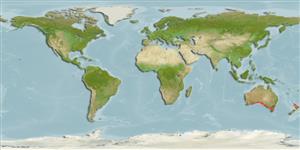Environment: milieu / climate zone / depth range / distribution range
Ecologia
marino; salmastro demersale; distribuzione batimetrica 1 - 100 m (Ref. 9563). Temperate; 30°S - 43°S
Indo-Pacific: known only from southern Australia.
Length at first maturity / Size / Peso / Age
Maturity: Lm 23.5 range ? - ? cm
Max length : 46.0 cm TL maschio/sesso non determinato; (Ref. 9563); peso massimo pubblicato: 3.1 kg (Ref. 6390)
Short description
Morfologia | Morfometria
Vertebre: 18 - 20. This species differs from Platycephalus westraliae in having the following characters: both second dorsal and anal fin rays usually 14 (vs. 13), total gill rakers 18-20 (vs. 10); palatine with a tooth band comprised of several irregular rows of conical teeth (vs. with an inner larger conical and an outer smaller villiform tooth rows); caudal fin with several small pale brown spots on the upper lobe and one or two large dark brown or black spots on the lower lobe, and with concave posterior margin (vs. with 3 dark bands and with mostly straight posterior margin) (Ref. 86914).
Inhabit coastal waters from shallow bays and inlets to depths of about 100 m over sand, shell grit and mud substrates (Ref. 6390). Sand flathead are usually solitary but may form loose aggregations (Ref. 2165, 27247). They sometimes move long distances (Ref. 6390). They are active foragers and ambush predators (Ref. 6390), occasionally are scavengers (Ref. 6390). Feed on crustaceans and fish (Ref. 2165). Its fin spines are venomous, can inflict mild to severe pain (Ref. 125684).
Life cycle and mating behavior
Maturità | Riproduzione | Deposizione | Uova | Fecundity | Larve
Paxton, J.R., D.F. Hoese, G.R. Allen and J.E. Hanley, 1989. Pisces. Petromyzontidae to Carangidae. Zoological Catalogue of Australia, Vol. 7. Australian Government Publishing Service, Canberra, 665 p. (Ref. 7300)
IUCN Red List Status (Ref. 130435)
Human uses
Pesca: commerciale
Informazioni ulteriori
BibliografiaAcquacolturaProfilo di acquacolturaVarietàGeneticaElectrophoresesEreditarietàMalattieElaborazioneNutrientsMass conversion
CollaboratoriImmaginiStamps, Coins Misc.SuoniCiguateraVelocitàModalità di nuotoArea branchialeOtolithsCervelliVista
Strumenti
Special reports
Download XML
Fonti Internet
Estimates based on models
Preferred temperature (Ref.
123201): 14.6 - 18.5, mean 17.1 °C (based on 242 cells).
Phylogenetic diversity index (Ref.
82804): PD
50 = 0.5000 [Uniqueness, from 0.5 = low to 2.0 = high].
Bayesian length-weight: a=0.00490 (0.00381 - 0.00630), b=3.06 (2.98 - 3.14), in cm total length, based on LWR estimates for this species (Ref.
93245).
Trophic level (Ref.
69278): 4.3 ±0.75 se; based on food items.
Resilienza (Ref.
120179): Medio, tempo minimo di raddoppiamento della popolazione 1.4 - 4.4 anni (K=0.19; tmax=9).
Fishing Vulnerability (Ref.
59153): Low to moderate vulnerability (29 of 100).
Nutrients (Ref.
124155): Calcium = 65 [6, 306] mg/100g; Iron = 0.792 [0.214, 2.004] mg/100g; Protein = 18 [16, 20] %; Omega3 = 1.01 [0.44, 2.67] g/100g; Selenium = 18.8 [5.0, 75.1] μg/100g; VitaminA = 25.4 [8.9, 72.5] μg/100g; Zinc = 0.651 [0.297, 1.378] mg/100g (wet weight);
